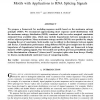Free Online Productivity Tools
i2Speak
i2Symbol
i2OCR
iTex2Img
iWeb2Print
iWeb2Shot
i2Type
iPdf2Split
iPdf2Merge
i2Bopomofo
i2Arabic
i2Style
i2Image
i2PDF
iLatex2Rtf
Sci2ools
RECOMB
2003
Springer
2003
Springer
Maximum entropy modeling of short sequence motifs with applications to RNA splicing signals
We propose a framework for modeling sequence motifs based on the maximum entropy principle (MEP). We recommend approximating short sequence motif distributions with the maximum entropy distribution (MED) consistent with low-order marginal constraints estimated from available data, which may include dependencies between nonadjacent as well as adjacent positions. Many maximum entropy models (MEMs) are specified by simply changing the set of constraints. Such models can be utilized to discriminate between signals and decoys. Classification performance using different MEMs gives insight into the relative importance of dependencies between different positions. We apply our framework to large datasets of RNA splicing signals. Our best models out-perform previous probabilistic models in the discrimination of human 5 (donor) and 3 (acceptor) splice sites from decoys. Finally, we discuss mechanistically motivated ways of comparing models. Key words: maximum entropy, splice sites, nonneighborin...
Computational Biology | Maximal Dependence Decomposition | Maximum Entropy | RECOMB 2003 | RNA Splicing Signals |
| Added | 03 Dec 2009 |
| Updated | 03 Dec 2009 |
| Type | Conference |
| Year | 2003 |
| Where | RECOMB |
| Authors | Gene W. Yeo, Christopher B. Burge |
Comments (0)

